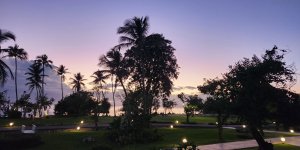| Published in Attractions / Places of Interest |
Trongsa Dzong, Bhutan
Kagyu Tradition, 16th century, 200 monks.
Trongsa Dzong is the largest dzong (fortress-monastery)1 in Bhutan, an important administrative building, providing the headquarters of the government of Trongsa District.

Trongsa Dzong, Bhutan. Photo: William L. Devanney, Wikipedia.
Location
History
Trongsa provided a strategic central location to control Bhutan for centuries. It was the seat of the Wangchuck dynasty of penlops (governors) who effectively ruled over much of eastern and central Bhutan, and from 1907 have been Kings of Bhutan.
Currently, is also a major monastic complex, with around 200 monks of Kagyu Tradition. During the summer months, the monastic community often relocates to Kurje Monastery in the Bumthang Valley.
Built on a spur overlooking the gorge of the Mangde River, a temple was first established at the location in 1543 by the Drukpa lama, Nagi Wangchuk son of Ngawang Chhojey.
In 1647, his great-grandson Shabdrung Ngawang Namgyal constructed the first dzong to replace it, called Chökhor Rabtentse Dzong with a shorter version of Choetse Dzong. It was enlarged several times during the 18th century.
The Chenrezig Lhakang was built in 1715 and a whole complex, including the Maitreya (Jampa) temple, was added in 1771. The dzong has since been repaired on several occasions; it was damaged during the 1897 Assam earthquake and underwent extensive renovation in 1927 and 1999.
Features
The Trongsa Dzong is the largest in all of Bhutan. It consists of a maze of courtyards, passageways and corridors and the complex contains as many as 25 temples. The most important temples are those dedicated to the Tantric deities of Yamāntaka, Hevajra, Cakrasaṃvara and Kālacakra.
The Maitreya (Jampa) temple was erected in 1771 and today contains a clay statue of the Buddha of the Future, donated by King Ugyen Wangchuck in the early 20th century.
The Temple of Chortens is located on the spot where the original 1543 temple had stood. It contains the funerary chorten of Ngagi Wangchuk and has 16 paintings of the Arhats and of the Buddha Akshobhya (Mitrugpa).
The watchtower of the fortress, named Ta Dzong, towers above the gorge to the east side of the dzong. It contains a temple, established in 1977 to honor the warrior god, King Gesar. In 2008, a museum was added to this complex, following Austrian donations.
The interior decorations in the temples are attributed to the time of the reign of the first ruler, king Ugyen Wangchuk. However, the Dzong has undergone renovations in recent years with assistance provided by an Austrian team.
The original design of the northern assembly hall, an original court scene with mural paintings of the guardians of four directions, Phurba statue in the main hall, a mural replica of Swayambunath temple of Nepal and a pictorial map of Lhasa are retained.
A printing house is located at the dzong, where printing of religious texts is done using traditional woodblocks.

Inside Trongsa Dzong. Photo: Stephen Shephard, Wikipedia.
Festivals
A five-day festival known as the Trongsa Tsechu is held in the northern courtyard of the temple during December or January. Every monastery in Bhutan observes this festival, which celebrates the arrival of Guru Rimpoche to Bhutan in the 8th century.
Masked dances are a popular feature along with the exposition of a very large thanka (religious painting) on cloth of Guru Rimpoche and other figures called the thongdrel. A fire blessing in the form of people running through "an archway of blazing straw" is also witnessed.
Travel and Visiting
Trongsa Dzong is about five to six hours by car from Thimphu and is open for visiting from 6:00AM to 5:00PM. Entry is free, and time required to visit is about two hours.
Sources
• https://en.wikipedia.org/wiki/Trongsa_Dzong
• https://www.triphobo.com/places/trongsa-bhutan/trongsa-dzong
Footnotes
1. Dzong is a distinctive type of fortified monastery architecture found mainly in Bhutan and Tibet. The architecture is massive in style with towering exterior walls surrounding a complex of courtyards, temples, administrative offices, and monks' accommodation.
YOU MAY ALSO LIKE






 If you own or manage a travel-related business such as a hotel, a bed-and-breakfast, a restaurant, a pub or a cafeteria, you can create a web page for your business for free on Titi Tudorancea Travel Info. » |